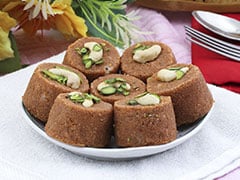Story ProgressBack to home
Jelly(जैली)
Hindi Name:जैली
Preserves of fruit prepared using gelatin or substitutes, usually for long term storage is called jelly. A sweet mix of fruit juice and sugar, often set in a fancy mould. It is a somewhat elastic spread made with fruits juices, sugar and gelatine. It is available in various flavors.
- NDTV Food
- Nov 21 2014 13:14 IST
 Preserves of fruit prepared using gelatin or substitutes, usually for long term storage is called jelly. A sweet mix of fruit juice and sugar, often set in a fancy mould. It is a somewhat elastic spread made with fruits juices, sugar and gelatine. It is available in various flavors. A fine jelly should be clear, sparkling and quiver when moved but hold form while being cut. Natural pectin, sugar or honey may be used to set the jelly. Contrary to popular belief, jelly can be sweet, savory or hot. Along with serving as a condiment with dessert, jelly is also consumed with toast or a sandwich.
Preserves of fruit prepared using gelatin or substitutes, usually for long term storage is called jelly. A sweet mix of fruit juice and sugar, often set in a fancy mould. It is a somewhat elastic spread made with fruits juices, sugar and gelatine. It is available in various flavors. A fine jelly should be clear, sparkling and quiver when moved but hold form while being cut. Natural pectin, sugar or honey may be used to set the jelly. Contrary to popular belief, jelly can be sweet, savory or hot. Along with serving as a condiment with dessert, jelly is also consumed with toast or a sandwich.
Nutritional Value
These tasty delights give the body a quick boost of energy and have only half the amount of calories and fat so they help maintain weight. They also help release stress and reduce the chances of stroke. reduced risk of kidney stones, lowered blood pressure and bad cholesterol are added advantages.
Types
Fruit Jelly: A variety of fruit jellies like apple, quince, plum, squash, orange, lychee, mango, strawberry are made.
Almond Jelly: A sweet dessert popular in Hong Kong.
Coffee Jelly: Japanese cuisine features it in many desserts.
Jellied Sauce: E.g. cranberry sauce jellied is a popular treat.
Grass Jelly: Often served in drinks, it is popular in China and Southeast Asia.
Muk: A jelly seasoned and served cold in Korea.
Nata de coco: Coconut jelly served in Philippines.
Yokan: Beans, sweet potato and squash is used to make this pasty and sweet delight served in Japan.
Did you know?
This concoction is simply called jam in British English.








